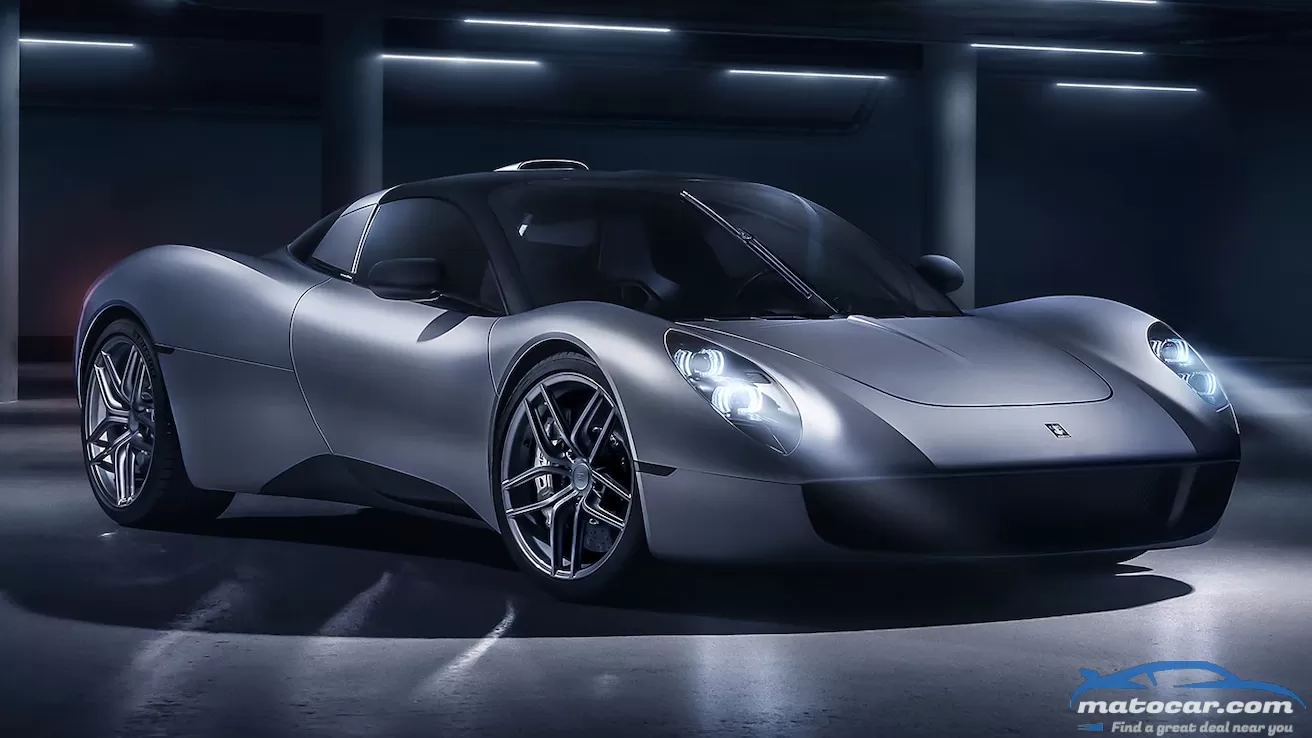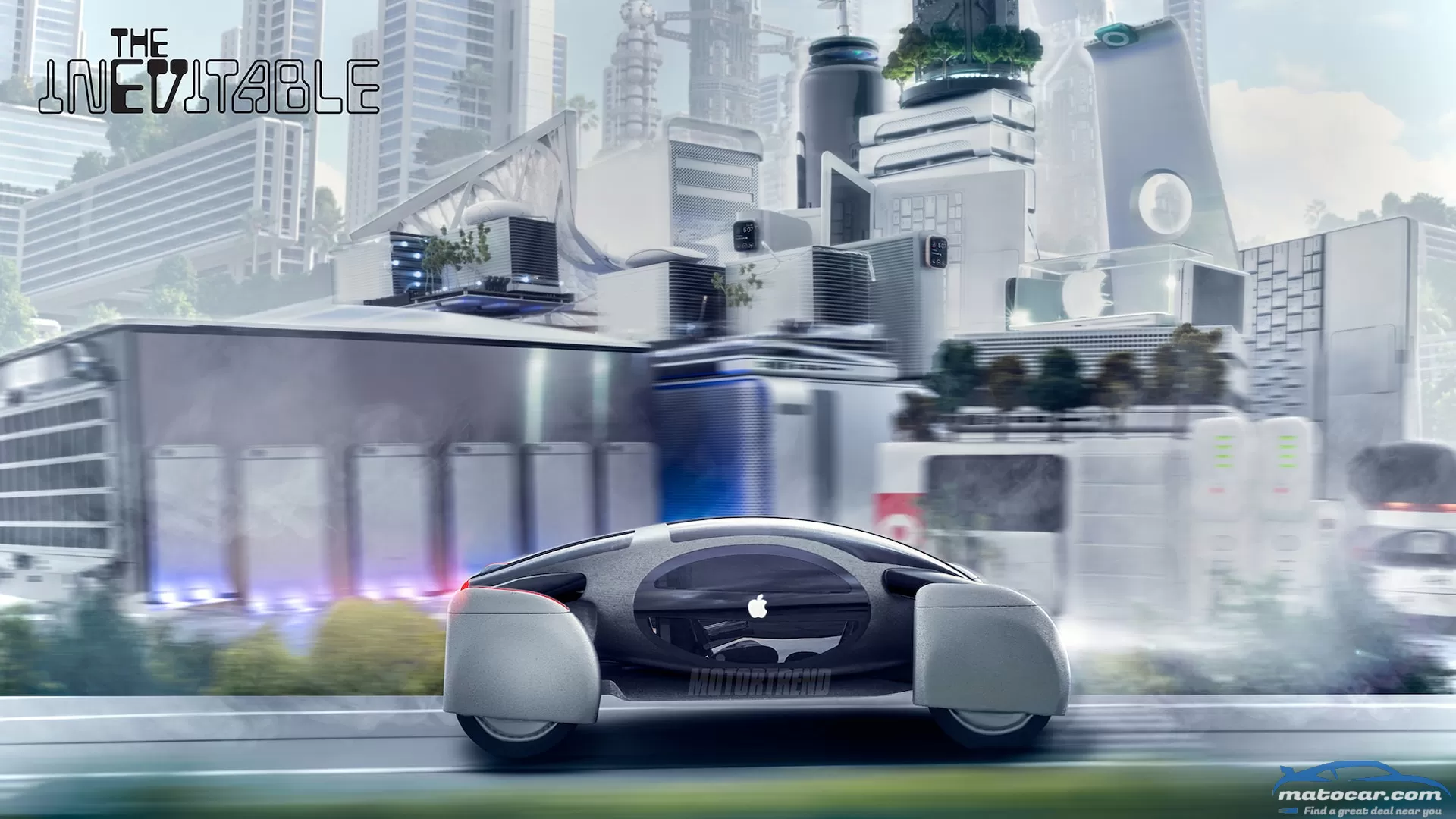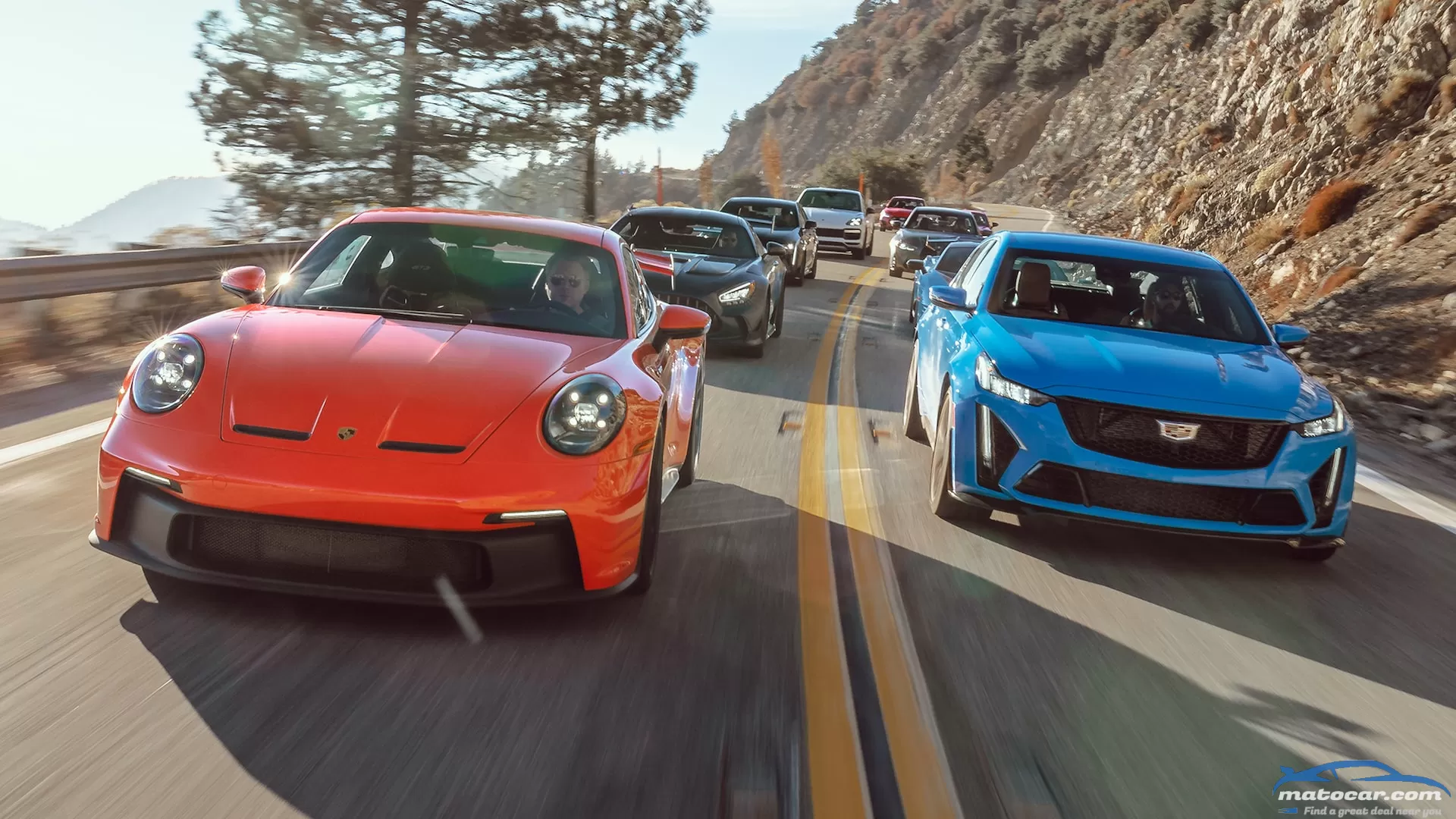GMA T.33 Hypercar: Inscrutable Name ... “Better Than the McLaren F1”?!

Is the GMA T.33 better than the McLaren F1? Gordon Murray smiles. "Oh, yes," he says. "The engine's better, the gearbox is better. It's lighter and has a slightly better power to weight ratio. The finish and the quality are much better."
The McLaren F1, created by Murray in the early 1990s at the height of his fame as a rock star grand prix race car designer, is widely regarded as the seminal hypercar, a car that set absolute benchmarks for on-road performance. One sold last year for more than $20 million. The GMA T.33, Murray's new ultralight, driver-focused mid-engine coupe will be priced from about $1.85 million, plus tax, when production starts in 2024.
In the context of today's McLaren F1 market, it sounds like a bargain.
The T.33 is the follow up to last year's T.50, the car Murray designed specifically as a 21st century successor to the McLaren F1 and a halo for his GMA brand. Like the T.50, it's powered by a high-revving naturally aspirated V-12 and will be available with a six-speed manual transmission. But beyond elements of the powertrain—and the air conditioning system and interior switchgear—the T.33 shares nothing with the T.50. It's a completely different car, designed for a completely different purpose.
The T.33's engine has less power, less torque, and a lower rev limit than the version used in the T.50 and T.50 Niki Lauda. Dubbed the Cosworth GMA.2 and distinguished by its yellow cam covers (the T.50's were orange and the T.50 Niki Lauda's red) it makes 607 horsepower at 10,500 rpm and 333 lb-ft of torque at 9,000 rpm, 47 hp and 11 lb-ft fewer than in T.50 spec. This is due to different cams, revised valve timing and engine mapping, and new intake and exhaust systems.
The decision to lop 1,000 rpm from the engine's top end wasn't just a case of ensuring differentiation between T.50 and T.33. "To be really honest," Murray says, "the main reason is that 12,100 rpm in a 4.0-liter engine with valve springs is getting right up there on the ragged edge. Going to 11,100 rpm makes much more sense." Just for reference, in T.50 spec the engine makes peak power at 11,500 rpm.
The other benefit is improved drivability. Murray says in T.50 spec the engine delivers 70 percent of its peak torque from just 2,500 rpm, but the T.33 version pumps out 75 percent of its peak torque at the same crank speed and 90 percent from 4,500 rpm. "I've never driven a V-12 with such low-down torque," he says of his test sessions in the T.50, "but the T.33 is on another level altogether."
As in the T.50, the T.33 V-12 drives the rear wheels through a six-speed manual transmission designed and developed by British motorsport specialist Xtrac. The T.33's transmission, which weighs just 177 pounds, shares its ultralight casing with the T.50 unit, but all the internals are new.
Unlike the T.50, the T.33 can be ordered with a paddle-shift transmission. Also developed by Xtrac, this transmission features the company's ingenious Instantaneous Gearchange System (IGS), which features an integrated ratchet and pawl mechanism between each gear hub and the main shaft so that two consecutive gear ratios can be selected and engaged simultaneously, but with only one set of gears driving. As there are no clutches to actuate, switching from one ratio to the next is, well, instantaneous, and there's no interruption to the torque flow.
Murray says the paddle-shift T.33 will be significantly quicker than the manual car, both in a straight line and on the track, but notes that of the 60 cars already pre-sold—like the T.50, just 100 are being built—only three have so far been ordered with the IGS transmission.
The T.33's chassis eschews the usual practice of bolting front and rear subframes to a central carbon-fiber tub. Instead, the car's central structure comprises Formula 1-style aluminum-core carbon-fiber panels bonded around aluminium tubes that run from front to rear. The carbon-fiber elements provide the essential torsional and bending stiffness, as well as a strong structure for crash safety, and the design eliminates the need for bolted joints.
"A bolted joint is messy and heavy, and it's flexible," Murray says. "No matter how well you do it, there's always a bit of joint movement at the transition from tube to carbon."
Up front, supporting the suspension, steering rack, and stabilizer bar, is a single aluminum casting, which Murray won't describe in detail other than to hint it's similar in concept to the organic Bionicast structure used at the rear of the Mercedes-Benz EQXX concept. At the rear, aluminum tubes simply cradle the engine, which is attached with just four bolts. The rear suspension is bolted directly to the transmission, and although the engine is rubber-mounted to reduce noise, vibration, and harshness, a clever trapezoidal link setup is used to lock the engine and transmission into place when subjected to loads through the rear wheels.
Murray reckons the innovative design of the T.33 chassis, which is loosely based on the iStream process he developed to build lightweight cars at low cost and high volume, makes it about 44 pounds lighter than a contemporary supercar chassis of a similar size. "It's taken two years to develop the technology, and we're thinking we might build the T.33 chassis ourselves to keep it in-house," he says.
Like all Gordon Murray cars, the T.33 is light. Target weight is just 2,403 pounds, a mere 230 more than the T.50 despite the car being engineered to be built in both left- and right-hand drive and meeting all U.S. and European crash regulations. That means the T.33 doesn't need massive brakes, wheels, or tires. The standard brakes are carbon ceramic, with relatively modest 14.6-inch-diameter rotors in front and 13.4-inch units at the rear. The tires are relatively modest, too—235/35 Michelin Pilot Sport 4s on 19-inch forged wheels up front and 295/30 items on 20-inch wheels out back. Power steering is by way of a new hydraulically assisted system specially developed for the car.
And like all Gordon Murray cars, the T.33 will have a relatively comfortable ride. "I never do stiffly sprung cars," Murray says. "I just don't like them. If you are going to drive it on a track, you're going to feel a bit of roll and pitch." However, for those customers who want to spend most of their time in their T.33s at track days, GMA will offer a sportier suspension setup. "The cars are so handbuilt, we can do virtually anything for the customers."
It's difficult to judge from the photos, but the T.33 is about the same length overall as a Porsche 718 Cayman even though its roofline is 5.5 inches lower and its 107.7-inch wheelbase is an astounding 10.3 inches longer. The pictures don't show the subtlety of its design, either, the overall flavor of which has been inspired by Murray's passion for 1960s mid-engine sports cars such as the Ferrari 206 SP Dino and the Alfa Romeo 33 Stradale.
The central driving position of the T.50 dictated a very cab-forward proportion. As the T.33 has a conventional driving position, which allows the pedals to be located farther rearward in the chassis, its cabin is, like those 1960s cars, more centrally located between the wheels. The wasp-waisted car also has a broad front air intake, pronounced haunches over all four wheels, and just the merest hint of a Kamm tail at the rear.
The relatively clean and simple surfacing belies some truly clever design details. There are no visible door handles; access to the cabin is via touch-sensitive buttons in the Gordon Murray Automotive logos at the base of the B-pillar. The fuel and oil fillers are hidden behind the panels on the pillars. The small vent at the base of the vertically stacked headlights not only ducts air to the front brakes but also allows the car to pass low-speed crash requirements while echoing iconic 1960s headlight graphics.
"There's nothing just for styling's sake on the car at all," Murray says. "Every single element has something to do. " The wide front air intake, for example, houses all the cooling hardware, which means there's no need for unsightly and un-aerodynamic ducts in the body side. Extra cooling air is ducted into the engine compartment from under the car.
The ram air intake above the cabin is another case in point. While in other mid-engine cars such intakes are part of the bodywork, in the T.33 it's mounted directly to the engine and stands proud of the bodywork so it can move. That eliminates the need for a flexible coupling, which means the internals of the entire intake can be kept perfectly smooth.
The other benefit, Murray explains, is more subtle: "If the intake is flush to the roof, you get a boundary layer buildup [of slow-moving air], which renders the bottom slice of the intake quite useless. By having the intake separate and floating above the car, we bleed off the boundary layer into the engine bay, which is low pressure, and then we can have a smaller, more aerodynamic duct."
Although the T.33 doesn't have the downforce of the fan-forced T.50, learnings from that car have been incorporated into the floor design. Two big diffusers at the front of the car help deliver downforce to the front axle. And while testing the T.50, Murray's team found the unique stepped diffuser at the rear of the car, which had been designed to work in conjunction with the fan drawing air through it, delivered 30 percent more downforce than expected with the fan switched off.
A revised version of the stepped diffuser layout is now a feature of the T.33's floor. "It was a happy accident," Murray says of the discovery. "But it means most of the downforce is developed at the front of the diffuser, near the car's center of gravity."
Combined with the two-thirds total downforce developed by the front diffuser, that means the T.33 doesn't need a splitter protruding from underneath the front air intake. The only active aero device on the car is a rear wing that tilts to maintain aero balance at high speed and flicks to near vertical under braking.
All this careful attention to aerodynamic detail has resulted in one very practical benefit: luggage capacity. In addition to being able to accommodate two cases in its full-width frunk, the T.33 can also carry two each in either side of the car, in compartments between the door opening and the rear wheel. To access the compartments, the entire rear quarter panels are hinged at the rear.
The GMA T.50, with its central driving position and fan-forced active aerodynamics, is a trophy car, the state-of-the-hypercar-art as expressed by the man who invented the concept 30 years ago. The GMA T.33 has been designed to similarly celebrate light weight and ultimate driving thrills, but also to have the ride quality and ground clearance and luggage capacity that allows it to be driven every day.
"I could see myself using one all the time," says Murray, whose current daily driver is the delightful, delicate Alpine A110. "If you had to have only one supercar, the T.33 is it."
There's another reason to desire a T.33, too. More V-12-powered GMA cars are coming—another two are planned over the next decade—but all will have some form of electrification to enable them to meet emissions regulations. "This will be our last nonhybrid car," Murray says. "If anybody wants the last, beautiful V-12 without any hybridization, this is the one."
You may also like
Speculation can be simple, a few folks gathered at a bar and wondering about the future. Creating a physical manifestation of that future and bringing it to life is anything but. Our process began with Garrett DeBry, an ArtCenter College of Design grad, concept artist for BMW and Toyota, and the man who developed our first Apple Car concept in 2016.DeBry is a proper futurist, spending hours poring over Syd Mead designs and listening to the Interstellar and Blade Runner 2049 soundtracks while working on sketches. From our side, we looked further into the future this time around, which afforded DeBry the freedom to design a vehicle that would fit into an Apple Car ecosystem, rather than imagining a comparatively simple autonomous Uber competitor.His inspirations range from the wraparound corner windows of Apple's flagship Chicago store to Amazon warehouse robots to the natural materials and organic shapes of the iconic midcentury modern Charles Eames lounge chair. On this project, DeBry worked to minimize automotive design to its core elements. This thought process is how we ended up with the ultra-slick suspended teardrop you see here, but that was only the start.Once DeBry submitted final sketches, we called on teams from around the world to lift his design off the page. Our second take on the Apple Car was painstakingly modeled in CAD so we could provide the files to a local 3-D print shop. After multiple days printing the 16-piece scale model you see here and bringing DeBry's design into the material world, it received countless coats of paint and finishing touches.Once we reached that point, Mumbai, India-based automotive photographer Kunaal Kelkar came to town to employ his own wizardry. Kelkar's work first came to our attention in 2020 when he published a shockingly realistic photo set that was in reality a scale Lamborghini Huracán posed on a wet treadmill. For the Apple Car, he spent four days building a future city almost entirely out of Apple products found around our offices. The results speak for themselves.
A member on the Bronco6G forum noticed something a little funny recently: The 2022 Ford Bronco configurator no longer features the image of the base level Bronco, and the entry-level model is no longer selectable at all. We took a look for ourselves and found that, indeed, the base Broncos are gone and only the price and wording remains above a grayed-out "image missing" graphic. That same Bronco6G forum poster also mentions that a user's local dealer explained their reasoning behind the move.Is There A Replacement?As it seems that Ford has removed the base Bronco from its configurator, we have yet to hear of any official new entry-level trim for the popular SUV. The post was made on January 11, 2022 and the last webpage crawl from the Internet Archive was back on November 19, 2021. We don't know when this was changed and how long it's actually been this way, though if you mess with the Ford website's url to force it to show the 2021 Bronco configurator, the base Bronco tile appears normally and you can build one. It could be that ongoing supply chain issues (and hardtop problems) are impacting the base-level 2022-model-year Bronco, so Ford is putting the kibosh on ordering one (it wouldn't be the first such limit or delay Ford has levied on Bronco intenders).At the time of this writing we have yet to get official word from Ford on the reason the Base model is gone. Either way, the blanked-out base Bronco leaves the two-door Bronco Big Bend version as the new price leader—though for 2022 it starts at $35,280, a far cry from the $30,795 listed for the two-door base version.A Dealer RumorHowever, the rumor mill is picking up where the base Bronco's faint scent trails off. On that same forum post, a member mentions talking to their local dealer about the loss and what was coming. (Again, we have no official word from Ford to verify this and so it should be taken with a grain of salt.) The explanation is that dealers were having trouble with selling the base Bronco for a profit versus other trims and weren't ordering as many.We find that somewhat hard to believe, given the popularity of the Bronco and the stories of people who were willing to fork over cash for one—any Bronco at all, really. Ford does not release monthly sales figures nor do they break down trims in their quarterly figures, so the base Bronco's fate at the hands of dealer ordering preferences or customer preferences are a mystery.A First-Gen Call Back?One interesting theory, on the other hand, was a mention of a "Heritage Edition" to replace the base model. It was described to a forum member as a standard Bronco with a white roof, calling back to the original, first generation Bronco. Given Ford's history of playing up its historic models, we can't say that isn't too far fetched. Again, we must stress that we have reached out to Ford for confirmation on all of this—the loss of the base model and the introduction of a Heritage model—and, as of press time, Ford has not responded to our questions. So don't rush to conclusions until we're able to confirm from Ford any of it is true. If or when we do hear back, we'll update this story.
It's time to present the finalists for the inaugural MotorTrend Performance Vehicle of the Year. Yes, after running through our contenders—those rides that missed the cut for the final round of voting the PVOTY honors, we're introducing those that did make the finalist cut. One of these vehicles earned our Golden Calipers, having excelled in all six of our criteria (safety, value, advancement in design, engineering excellence, efficiency, and performance of intended function). The weighting of some of those criteria may differ slightly from our Car, Truck, and SUV of the Year competitions—after all, when outright performance is our focus, efficiency is perhaps graded on a curve—but every single one is considered when choosing our winner.Read on to meet the first four members of our finalist field—the rest will be unveiled tomorrow—to represent the cars that made it out of our initial round of voting following evaluations at Hyundai's Proving Ground outside of Los Angeles. The finalists then went on to road drives on Angeles Crest Highway and, later, grueling track tests at Willow Springs Raceway. Come back on Monday, February 14 to see which one emerged with the title!




0 Comments